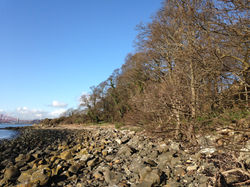Dalgety Bay Community Woodlands Group

 |  |  |  |  |  |  |
|---|---|---|---|---|---|---|
 |  |
Hopeward Wood
This is the largest of the woodlands at approximately 1.2 ha and is bounded at east, west and north by original stone walls which may date back to the enclosure of the estate lands. It is a broad leaved woodland, mainly of Sycamore and Wych Elm with occasional Oak, Beech and Ash and a couple of ornamental Whitebeam. In the shrub layer are occasional Elder, Rowan, Hawthorn, and at the seaward edge an extensive thicket of Blackthorn.
The Fife Coastal Path threads its way through the woods giving views of the Forth through the trees.
 |
|---|
 panorama.jpg |
 nice view.jpg |
 bathinghouse 2.jpg |
 bench.jpg |
 bridge view.jpg |
 habitat.jpg |
 photo 3.jpg |
 crow wood sign.jpg |
 photo 4.jpg |


The ground flora includes an extensive area of Bluebells, mostly native, which form a carpet of blue in the spring.


Ivy and Bramble can form dense ground cover, especially on the steeper slopes, but there are also White and Red Dead-nettle along the path sides which, because of their early flowering, are an important source of nectar for queen Bumblebees emerging in the spring. Other flowers include Hedge Woundwort and the inconspicuous Dog’s Mercury, both indicators of ancient woodland. Red Campion, Garlic Mustard and Cow Parsley also flower before the tree canopy is complete.

Queen of the Early Bumblebee feeding on Red Dead-nettle in early April

Garden Bumblebee worker taking nectar from Hedge Woundwort
Just to the west of Hopeward Wood, and adjacent to the Coastal Path, is a grassy area with some shrub and tree planting. This provides good views of the Forth Rail Bridge and the aim is to retain this view and establish it as a wildflower area.
